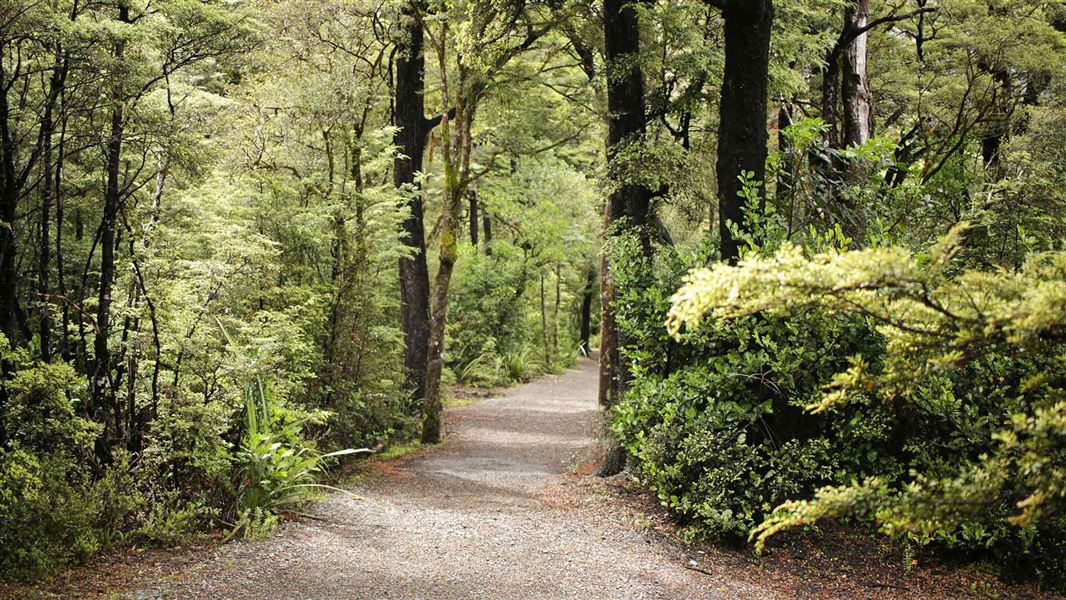Bellbird Walk
Time: 15 min
The short, wheelchair-standard Bellbird Walk gives an introduction to the Rotoiti Nature Recovery Project area. This sheltered corner of the lake attracts nectar-feeding birds such as tūī and bellbirds to the large red beech trees that dominate this area. Listen for their enchanting calls as you take this walk. Keep an eye out for other insect-eating forest birds as well.
The track begins at the car park near the east jetty at Kerr Bay. Allow 5 minutes walking time for this as well as 10 minutes or so to read the information panels along the way. The deciduous New Zealand fuchsia, which is rare in much of the forest due to browsing by possums, may be seen in several places along this walk. The pathway returns through a small wetland area where sedges, rushes, ferns and mosses thrive.
Getting there: The walk starts at the end of Kerr Bay Road in St Arnaud.
Honeydew Walk
Time: 45 min
This walk branches off from the Bellbird Walk. It takes you further into the Rotoiti Nature Recovery Project area along a high-standard track. The surface is suitable for wheelchairs but would need someone to push on the steeper slopes.
The blackened trunks and branches of most of the red and mountain beech trees along the walk are brought about by a small scale insect that buries itself within the bark of the tree.
This insect feeds on the sugar-rich sapwood of the tree and excretes any excess sugar surplus to its requirements out through a long, white, hair-like anal tube. The black sooty mould that coats these trees, without harming them, thrives on the sticky ‘honeydew’ produced by the scale insect. Many animals, such as nectar-feeding birds, insects and lizards, rely heavily on collecting these nutritious honeydew droplets for food.
Bellbirds and tūī are common in this area, and you may see robins, tomtits and fantails. You may also glimpse kākā or hear kākāriki chattering as they fly through the canopy.
Getting there: Start on the Bellbird Walk at the end of Kerr Bay Road in St Arnaud.
Loop Track
Time: 1 hr 30 min
Start the track by taking the Bellbird Walk and Honeydew Walk before turning left to follow the St Arnaud Range/Loop Track. From here, the track climbs a series of terraces to a junction at a creek and then loops back and down until you re-emerge at the lakeshore and join the Lakehead Track, which returns to the car
park.
The track is likely to be a bit muddy after rain. Three species of the palatable beech mistletoe are evident in places; you may see their red and yellow flowers in December/January. These bear testament to the effectiveness of the possum control work being carried out in the recovery project area.
Getting there: Start on the Bellbird Walk at the end of Kerr Bay Road in St Arnaud.
Black Valley Walk
Time: 30 min
This walk follows the Black Valley Stream through majestic beech forest. The Black Valley stream has cut its way through deposits of rubble dumped by past glaciers. You may notice that some trees along this walk are banded with metal strips. These are placed to prevent possums from climbing the trees and destroying the beech mistletoes that grow in the crowns of these trees.
Getting there: The walk starts in the Kerr Bay Campsite, on Kerr Bay Road in St Arnaud.
Brunner Peninsula Nature Walk
Time: 1 hr
This walk starts at the western side of Kerr Bay. It follows the peninsula around into West Bay, twice crossing the Alpine Fault. Return via Baxter Street or Cotterell Street and View Road. Panels along the way give an insight into the history of the area. For a longer walk (1 h 30 min) continue to the next junction and turn right,
returning to Kerr Bay via Rotoiti Lodge and Ward Street. This walk has a good variety of native plants and several easy access points to the lakeshore.
Getting there: Start this walk on Kerr Bay Road, just below the Nelson Lakes Visitor Centre in St Arnaud.
Start these walks from Kerr Bay in St Arnaud.
- Be prepared with warm and waterproof clothing. Nelson Lakes National Park is in an alpine area – freezing conditions can occur at any time of year.
- No rubbish facilities are provided – carry out all your rubbish.
- Biting sandflies can detract for your experience at the lakes, especially during the summer months – cover up and apply a good quality insect repellant to exposed skin.
- Wasps are a known hazard and are particularly common from December until April – carry antihistamine if you are allergic to their stings.
All drone use must be authorised by DOC
You must have a permit to fly a drone on public conservation land.
Visit our Drone use on conservation land page for more information.
The Rotoiti Nature Recovery Project area extends south along the eastern lake shore of Lake Rotoiti. It's one of six ‘mainland island’ projects.
With the assistance of a voluntary group, the Friends of Rotoiti, DOC manages over 5000 hectares of honeydew beech forest. By intensive trapping and use of poisons, the numbers of pests such as possums, stoats, ferrets, weasels, rats, mice and wasps have been reduced and native species have recovered.
Nelson Lakes National Park Visitor Centre
| Phone: | +64 3 521 1806 |
| Email: | nelsonlakesvc@doc.govt.nz |
| Address: | View Road St Arnaud 7072 |
| Hours: | Visitor centre hours and services |
Whakatū/Nelson Visitor Centre
| Phone: | +64 3 546 9339 |
| Email: | nelsonvc@doc.govt.nz |
| Address: | Millers Acre/Taha o te Awa 1/37 Halifax Street Nelson 7010 |
| Hours: | Visitor centre hours and services |
